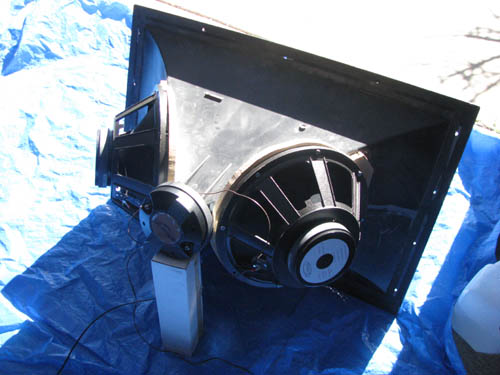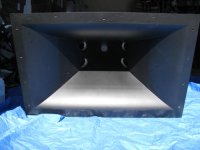I am a member also of the Klipsch forum and this guy Chris A has done something along the lines of Danley with a K-402 horn.
https://community.klipsch.com/index.php?/topic/161404-a-k-402-based-full-range-multiple-entry-horn/
https://community.klipsch.com/index.php?/topic/161404-a-k-402-based-full-range-multiple-entry-horn/
Yeah, looks like Chris took my suggestion from 10/3/14 post #25:I am a member also of the Klipsch forum and this guy Chris A has done something along the lines of Danley with a K-402 horn.
https://community.klipsch.com/index.php?/topic/161404-a-k-402-based-full-range-multiple-entry-horn/
http://www.diyaudio.com/forums/multi-way/262797-cons-pros-different-midbass-horns-3.html
Seems to have worked out nicely!
Art
I just saw this thread, so maybe I'll summarize the differences between this design and the typical DIY multiple-entry horns that I see on this forum and elsewhere:
1) This isn't a dual flare conical horn--it's what most would call a "conical tractrix" horn--a straight-sided horn throat area that feeds a full dual-axis tractrix flare mouth. The horn's inventor calls it "modified tractrix", because that's exactly what it is.
2) I find that the 50x50 and 60x60 degree horns just don't have enough horizontal coverage. This horn covers 100 x 60 quite well. In fact, it's the most spectacular horn that I've seen in that regard. Anechoic chamber measurements of its polar performance can be found in the linked thread, as well as outside REW-based measurements for verification of its performance relative to the conventional compression driver-only K-402.
3) This is a two-way design using dual 15" woofers for low frequency extension that eliminates the need for a midbass horn. In a corner, this loudspeaker has LF extension that exceeds the Khorn and Jubilee bass bins (although I still recommend crossing to a separate horn-loaded sub or two to control modulation distortion). I find that there is no reason to put midrange driver in a home hi-fi based multiple entry horn. Using 2" compression drivers of sufficient quality yield much better overall performance.
4) I use a good quality active digital crossover for this loudspeaker--not a low-SNR miniDSP or a Behringer or dbx with analog fidelity issues. I find that so much time and effort is expended on passive crossovers that in the end yield still-wanting performance. An active digital crossover of good quality eliminates those issues, as well as provides extensive EQ and delay capabilities to dial-in the loudspeakers for the room and position within the room where they are located. [I've been using good quality active digital crossovers for about 7 years now with all the 5.2 loudspeakers in my setup. I no longer recommend passive crossovers for home use under any conditions except extreme low cost based on that experience.]
5) The sound of this loudspeaker vs. Jubilees on each side is spectacular in terms of its midbass performance, single-point source, and polar control throughout its passband--down to 175 Hz--low enough for quarter or eighth-space room loading. This coupled with the decreased sensitivity of human hearing to detect the loss of polar control (but not all the benefits of horn loading) yields an extremely clean sounding and coherent point source capability that I've not heard elsewhere.
6) In effect, the loudspeaker is a full-range horn loaded configuration without the need for any direct radiating woofers, which themselves introduce a great many issues in terms of sound quality.
7) This design isn't a typical diy "let's see how this works" design, but much higher fidelity design that currently exceeds that which can be purchased for home hi-fi use. The cost to diy is much less than any commercially-bought loudspeaker of similar configuration, as well as having superior home hi-fi qualities that I've found are unavailable elsewhere.
YMMV.
Chris A
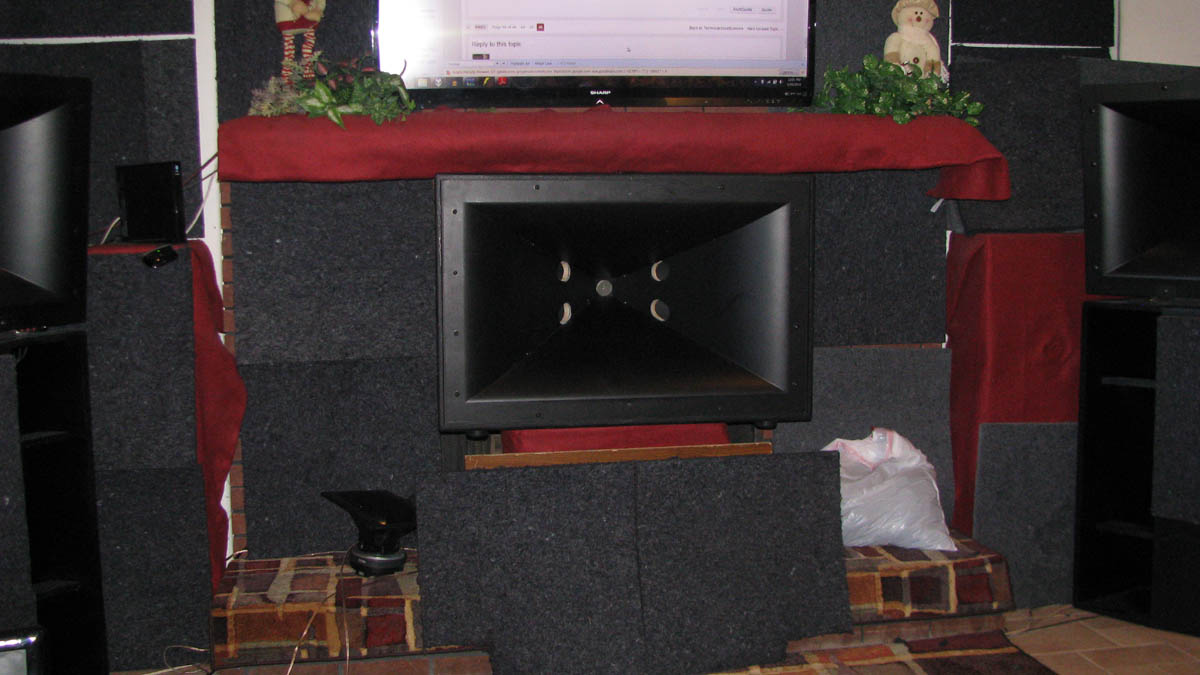
1) This isn't a dual flare conical horn--it's what most would call a "conical tractrix" horn--a straight-sided horn throat area that feeds a full dual-axis tractrix flare mouth. The horn's inventor calls it "modified tractrix", because that's exactly what it is.
2) I find that the 50x50 and 60x60 degree horns just don't have enough horizontal coverage. This horn covers 100 x 60 quite well. In fact, it's the most spectacular horn that I've seen in that regard. Anechoic chamber measurements of its polar performance can be found in the linked thread, as well as outside REW-based measurements for verification of its performance relative to the conventional compression driver-only K-402.
3) This is a two-way design using dual 15" woofers for low frequency extension that eliminates the need for a midbass horn. In a corner, this loudspeaker has LF extension that exceeds the Khorn and Jubilee bass bins (although I still recommend crossing to a separate horn-loaded sub or two to control modulation distortion). I find that there is no reason to put midrange driver in a home hi-fi based multiple entry horn. Using 2" compression drivers of sufficient quality yield much better overall performance.
4) I use a good quality active digital crossover for this loudspeaker--not a low-SNR miniDSP or a Behringer or dbx with analog fidelity issues. I find that so much time and effort is expended on passive crossovers that in the end yield still-wanting performance. An active digital crossover of good quality eliminates those issues, as well as provides extensive EQ and delay capabilities to dial-in the loudspeakers for the room and position within the room where they are located. [I've been using good quality active digital crossovers for about 7 years now with all the 5.2 loudspeakers in my setup. I no longer recommend passive crossovers for home use under any conditions except extreme low cost based on that experience.]
5) The sound of this loudspeaker vs. Jubilees on each side is spectacular in terms of its midbass performance, single-point source, and polar control throughout its passband--down to 175 Hz--low enough for quarter or eighth-space room loading. This coupled with the decreased sensitivity of human hearing to detect the loss of polar control (but not all the benefits of horn loading) yields an extremely clean sounding and coherent point source capability that I've not heard elsewhere.
6) In effect, the loudspeaker is a full-range horn loaded configuration without the need for any direct radiating woofers, which themselves introduce a great many issues in terms of sound quality.
7) This design isn't a typical diy "let's see how this works" design, but much higher fidelity design that currently exceeds that which can be purchased for home hi-fi use. The cost to diy is much less than any commercially-bought loudspeaker of similar configuration, as well as having superior home hi-fi qualities that I've found are unavailable elsewhere.
YMMV.
Chris A

Last edited:
Thanks, Bill. I just followed the yellow brick road, playing variations on a theme. The design is really quite simple.
The real credit goes to Tom Danley who clearly uses his deep knowledge of physics and engineering rather than "conventional thinking", along with a good ear and a little passion for home hi-fi and DIY: he's ignited a loudspeaker DIY fire. The balance of the ideas go to Roy Delgado who has helped teach a few guys much more effective approaches to achieve better sound.
I wish you all could hear this thing. It's fairly spectacular as-is and really fairly simple to achieve...if you think about what's important to diy...and what's not. The horn itself can be had for $285(US), and is the most impressive horn that I've ever heard.
Chris
The real credit goes to Tom Danley who clearly uses his deep knowledge of physics and engineering rather than "conventional thinking", along with a good ear and a little passion for home hi-fi and DIY: he's ignited a loudspeaker DIY fire. The balance of the ideas go to Roy Delgado who has helped teach a few guys much more effective approaches to achieve better sound.
I wish you all could hear this thing. It's fairly spectacular as-is and really fairly simple to achieve...if you think about what's important to diy...and what's not. The horn itself can be had for $285(US), and is the most impressive horn that I've ever heard.
Chris
Last edited:
I suspect it was more the less trod path than the yellow brick road! But you are right, people like Tom and Earl have really opened up the possibilities for those with the space and inclination. Still puts you in the vanguard showing us cowards the way!
Sadly my entire house has less square footage than your living room so I cannot fit beasties like that in. Maybe one day. I used to have a wife that didn't let me DIY. divorced her and now can't afford it due to the alimony
Sadly my entire house has less square footage than your living room so I cannot fit beasties like that in. Maybe one day. I used to have a wife that didn't let me DIY. divorced her and now can't afford it due to the alimony
Bummer... I think that there is a "bookshelf synergy" thread going on this forum that looked very interesting.
The things that I've found that really lower the threshold of fear for diy multiple-entry horns:
1) Use digital active crossover that you buy used, of good quality (this one point probably halves the total time), and
2) Use conical-tractrix, i.e., "modified tractrix" horns (like the very small Klipsch K-510) instead of trying to hold throat tolerances on a diy conical dual-flare horn (much less than 1 mm total throat tolerance as it turns out).
3) Avoid using midrange drivers. Instead go to full-range 2" compression drivers and use their ability to go from 400 Hz - ~20 kHz in one step. Because of the low mass and extremely small diaphragm motions, FM distortion is almost unmeasurable, even at high in-room SPL).
4) Try to avoid using direct radiating woofers in a vented box- instead load them on a conical horn instead below Fc, like Danley does, and use the digital crossover to take out the FR/phase issues.
I've been using the K-402 and full-range compression drivers on the K-402 horn for about 8 years now, and I can tell you that it's spectacular to listen to.
I've also been using the K-510 horn for about 1 1/2 years, and as bookshelf-sized units, they're unsurpassed in my experience. That little horn can hold its polars down to about 500 Hz.
Chris
The things that I've found that really lower the threshold of fear for diy multiple-entry horns:
1) Use digital active crossover that you buy used, of good quality (this one point probably halves the total time), and
2) Use conical-tractrix, i.e., "modified tractrix" horns (like the very small Klipsch K-510) instead of trying to hold throat tolerances on a diy conical dual-flare horn (much less than 1 mm total throat tolerance as it turns out).
3) Avoid using midrange drivers. Instead go to full-range 2" compression drivers and use their ability to go from 400 Hz - ~20 kHz in one step. Because of the low mass and extremely small diaphragm motions, FM distortion is almost unmeasurable, even at high in-room SPL).
4) Try to avoid using direct radiating woofers in a vented box- instead load them on a conical horn instead below Fc, like Danley does, and use the digital crossover to take out the FR/phase issues.
I've been using the K-402 and full-range compression drivers on the K-402 horn for about 8 years now, and I can tell you that it's spectacular to listen to.
I've also been using the K-510 horn for about 1 1/2 years, and as bookshelf-sized units, they're unsurpassed in my experience. That little horn can hold its polars down to about 500 Hz.
Chris
Bummer... I think that there is a "bookshelf synergy" thread going on this forum that looked very interesting.
Yeah I've been following that. Almost small enough I could build. If I pole mounted them. My current speakers are 12" wide and they get in the way.
At least in a small room max SPLs are not an issue which opens up options.
All fun, all good
Chris,A view of the drivers attached to the horn:
Nice work!
Why do you have it unenclosed, have you gone to the OB "dark side" ;^)?
The Klipsch horn Looks a lot more conical than tractrix to me, could you shoot an overhead shot for a better viewing of the transitions between the flare types?
Art
The whole assembly is enclosed in a trapezoidal box (closed--no vents). I don't prefer the sound of bass reflex enclosures. I sized the woofers so that I didn't have to use vents.
It might be a little while before I get it apart again. In the mean time, here is a front view shot that may be better:
It might be a little while before I get it apart again. In the mean time, here is a front view shot that may be better:
Attachments
Here is an image that I took the day that I received my original set of Klipsch Jubilees (2007):
An externally hosted image should be here but it was not working when we last tested it.
And a side view taken by Bjorn of one of his K-402s:
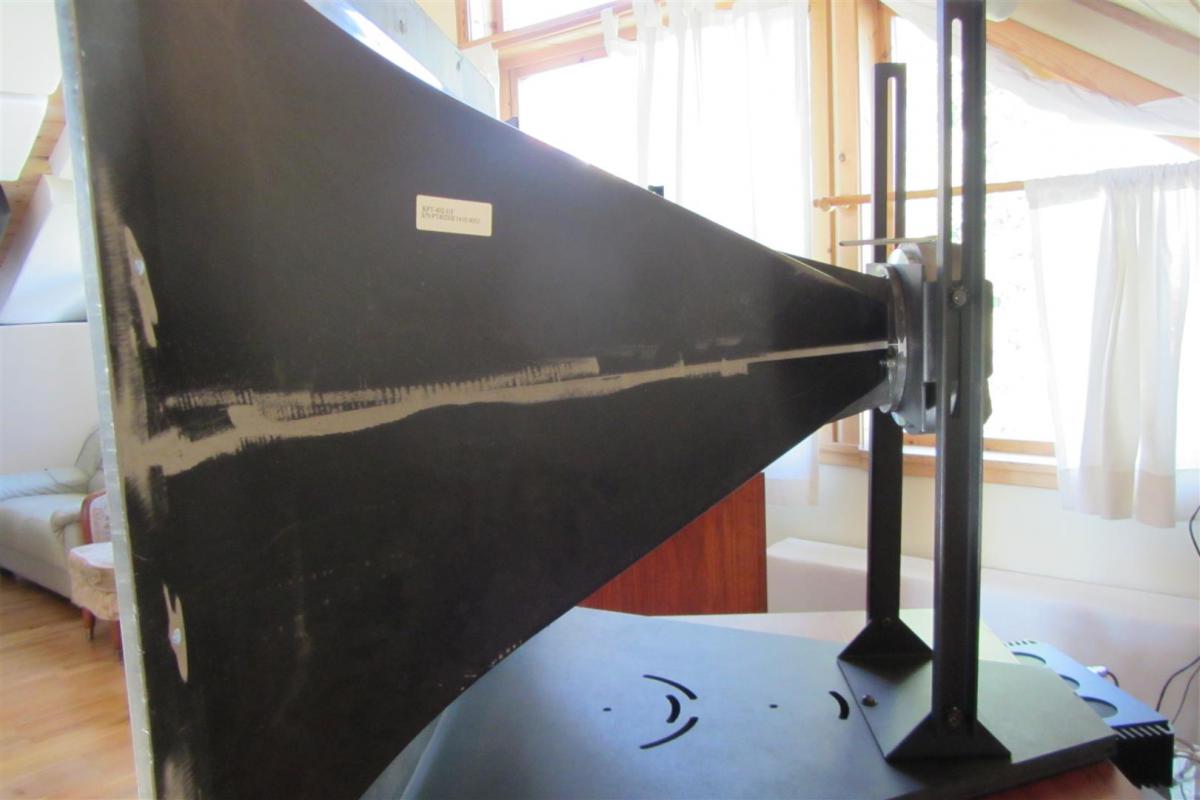
It looks the same in the other axis, except the horizontal coverage angle (from horn centerline). The designer (Roy Delgado) specifically says that the expansion is not conical--but rather modified tractrix (with straight-sided walls). If you follow Beranek's or Olson's equations, it isn't a strictly conical expansion, and it proceeds from the mouth, not the throat, as tractrix curves are typically constructed.
The horn's polars:


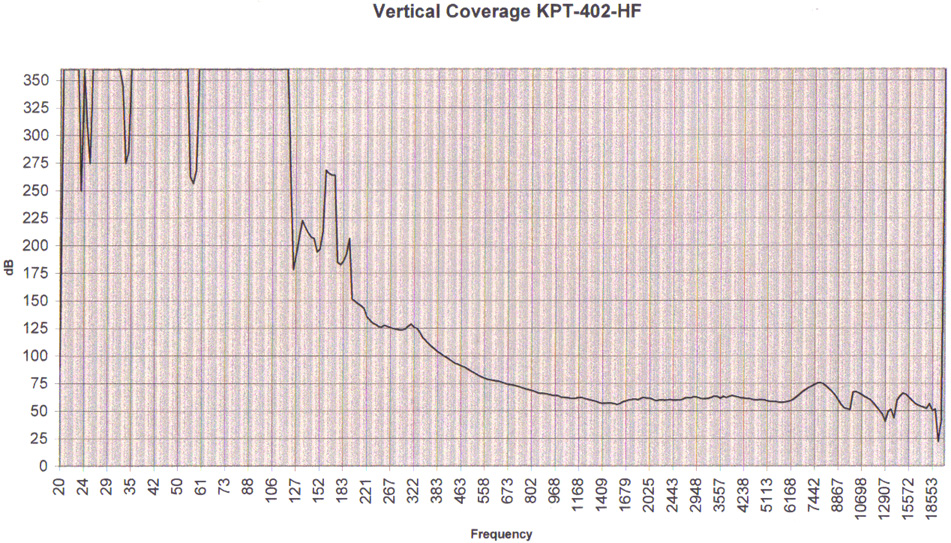
Chris

It looks the same in the other axis, except the horizontal coverage angle (from horn centerline). The designer (Roy Delgado) specifically says that the expansion is not conical--but rather modified tractrix (with straight-sided walls). If you follow Beranek's or Olson's equations, it isn't a strictly conical expansion, and it proceeds from the mouth, not the throat, as tractrix curves are typically constructed.
The horn's polars:


An externally hosted image should be here but it was not working when we last tested it.

Chris
Last edited:
Thanks for the photos and polars.It looks the same in the other axis, except the horizontal coverage angle (from horn centerline). The designer (Roy Delgado) specifically says that the expansion is not conical--but rather modified tractrix (with straight-sided walls). If you follow Beranek's or Olson's equations, it isn't a strictly conical expansion, and it proceeds from the mouth, not the throat, as tractrix curves are typically constructed.
Chris
In other words, it is a conical expansion from the mouth up to the secondary horn break, which transitions to a tractrix curve for the last few inches of the horn.
Polars indicate it works quite well, but the Horizontal and Vertical coverage charts are bizarre, low frequency response exceeding a Saturn V rocket launch, perhaps that should be "phase angle", not "dB" on the vertical axis ;^).
Art
Last edited:
Cask05,
Very nice work and great fit of the woofers into the relatively flat sides. On my tractors LTH142, the steeply curved sides require quite a thick adapter plate to mate with woofer.
The band pass injection holes you have a quite large and within close proximity to throat. Do you have data showing effect of the holes relative to factory polars on pristine horn?
I had an issue on mine with 2in dia holes whixh were subsequently replaced with smaller equivalent of 36mm holes with seven smaller holes.
Very nice work and great fit of the woofers into the relatively flat sides. On my tractors LTH142, the steeply curved sides require quite a thick adapter plate to mate with woofer.
The band pass injection holes you have a quite large and within close proximity to throat. Do you have data showing effect of the holes relative to factory polars on pristine horn?
I had an issue on mine with 2in dia holes whixh were subsequently replaced with smaller equivalent of 36mm holes with seven smaller holes.
- Status
- This old topic is closed. If you want to reopen this topic, contact a moderator using the "Report Post" button.
- Home
- Loudspeakers
- Multi-Way
- A different horn
